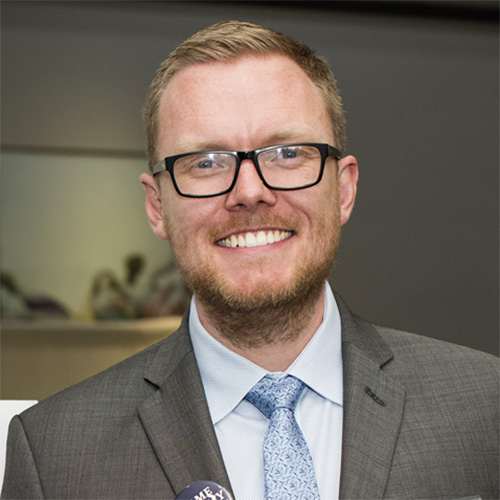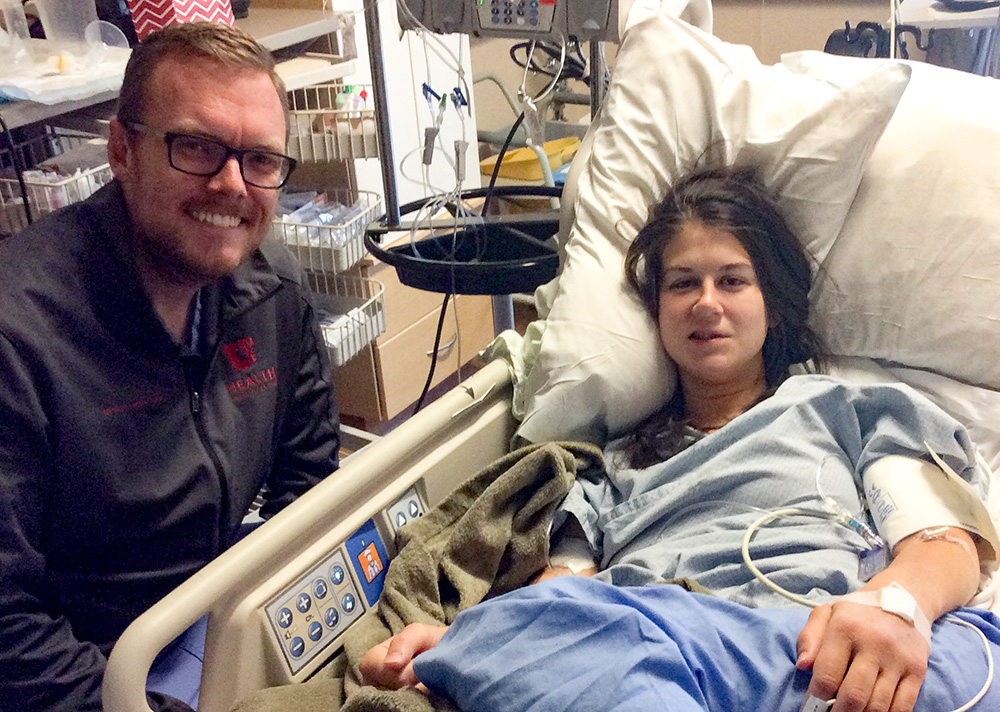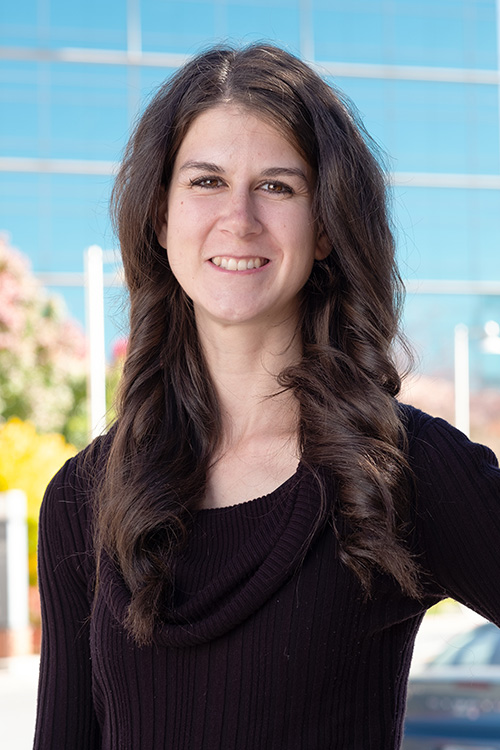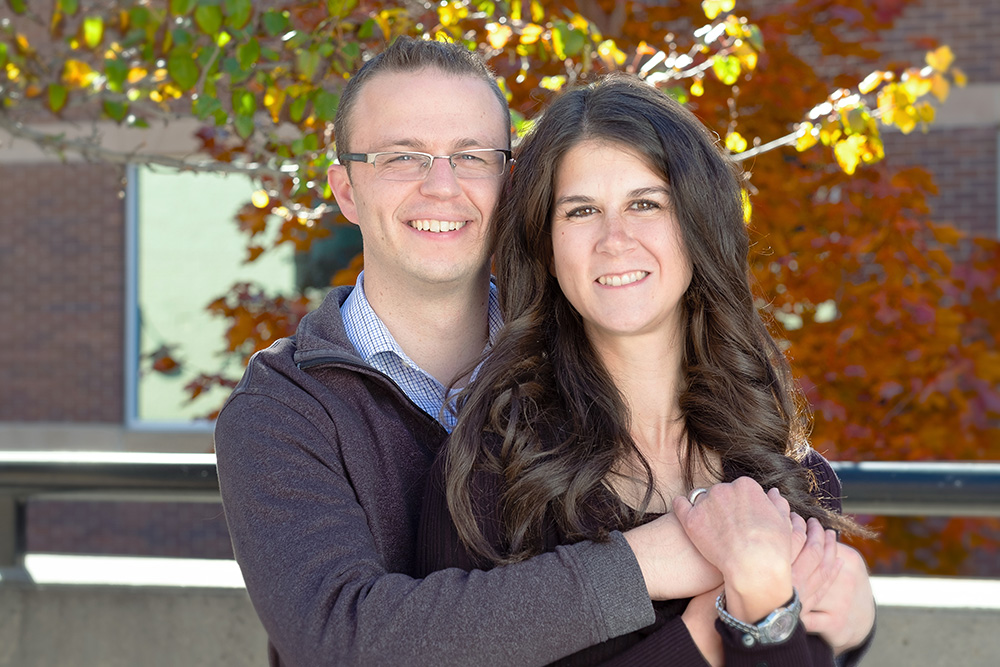By William Morris
On the morning of November 20, 2017, Whitney Meyers was getting her children ready for school when she started to feel dizzy. She was climbing the stairs, carrying her youngest child, and suddenly thought, “I need to lie down.” Whitney reached the top of the stairs, then set down her son and lay beside him on the floor.
Mornings for the Meyers are hectic at best. Whitney, 32, is a wife and mother with four young children. She helps her husband Tim get ready for work, then feeds her infant son and packs lunches for her older children before sending them to school. On that Monday morning, though, Whitney could not get off the floor. She knew her daughters were running late for school, but no matter how urgent the situation, her body would not cooperate. She asked her eight-year-old daughter for help up, and tried to use a nearby chair for support. Nothing worked.
“My body had no strength,” Whitney recalls. “I thought to myself, ‘you need to get help.’”
It was a mixed blessing that her older daughters were not yet at school. Unable to find her phone, they ran to Whitney’s sister’s house, thankfully in the same Farmington neighborhood. Finding her sister on the floor, she knew immediately that they needed to call an ambulance.
“Your face is drooping,” she said. “You’re having a stroke. We need to call 9-1-1.”
First responders arrived within minutes. They whisked Whitney to a local hospital where she was first treated with the “clot-buster” medication, Tissue Plasminogen Activator.
Shortly after, Whitney was transported by helicopter to the Emergency Room at the University of Utah. Tim Meyers is an employee of the University, and all of their children were born at University Hospital. While her memory of the stroke is hazy and incomplete, Whitney recalls feeling relief when she was told she was being taken to the University for further treatment. “This is where I’d like to be if I have a serious health problem,” Whitney says.
A Small Incision and a Quick Procedure
 |
| Matthew Alexander, MD, PhD, Interventional Neuroradiologist |
“In treating stroke patients, time is brain,” asserts Matthew Alexander, MD, who treated Whitney that day. In other words, the longer a patient’s brain suffers lack of blood flow, the higher risk they have of brain loss.
The stroke team at the University of Utah is a well-oiled machine. Whitney immediately received a CT scan so Alexander could determine the location and severity of the blood clot that was starving her brain. Alexander determined that he could attempt to remove the clot with a minimally invasive procedure and prepped for a mechanical thrombectomy.
As a neurointerventional surgeon in the Departments of Radiology and Imaging Sciences and Neurosurgery, Alexander is a seasoned pro at these types of procedures. Interventional radiology is a field in which doctors perform minimally invasive procedures on patients using image guidance. Within this medical specialty, neurointerventional radiology (NIR) focuses specifically on the blood vessels, brain, and spinal cord.
“I always knew I wanted to treat and do research with the nervous system,” recalls Alexander.
Alexander was introduced to the new and rapidly growing field of NIR while studying at Columbia University. In the early days of the field, 30 years ago, when doctors first had access to the kinds of image-guidance that made NIR possible, they would have to improvise materials in order to address the myriad nervous system conditions they could now treat. It was a rich time of growth for a new set of procedures developed through much experimentation. “Some of the people who trained me started their training in the mid-1980s,” says Alexander, “and the people who trained them were, to an extent, making it up on the fly.”
By the time Alexander started his NIR training as a fellow at the University of California, San Francisco, the field had matured to the point that doctors no longer “made it up on the fly.” Doctors today also have more tools at their disposal and Alexander notes that there is still a lot of growth and innovation in the field.
Stroke treatment, in particular, has been transformed by advances in NIR. “In the past, stroke was, if not a death sentence, a disability sentence for large vessel occlusions,” Alexander states. In these cases, large areas of the brain would die from blood loss and swelling. Without the type of procedure Alexander performed, Whitney would have needed surgery to remove part of her skull in order to reduce swelling and bleeding. In such cases, patients rarely recover full brain function, often leaving them severely disabled.
Mechanical thrombectomy is a bit like spear fishing. During the procedure, Alexander threaded a thin wire through Whitney’s body, beginning from a single small incision near her groin. The wire was navigated using imaging guidance, into Whitney’s brain, where it crossed the clot in her artery. He then passed a small micro catheter (“Really just a long, thin plastic tube,” as Alexander describes it) over that wire until it had gone past the clot. He then placed a device called a stentriever in the catheter, which is like a round metal cage that does not detach from the wire. The stentriever opened into the clot, and Alexander now had a handhold on the cause of Whitney’s stroke.
Alexander applied suction to make sure none of the clot broke apart and traveled further into Whitney’s brain, and then he carefully pulled the speared clot back through the same path the wire had traveled to arrive at her brain. Eventually, the catheter, stentriever, and clot emerged from the small incision in her groin.
In all, the procedure took under an hour and open brain surgery was not needed.
 |
| Dr. Alexander and Whitney shortly after her minimally invasive mechanical thrombectomy. |
An Unexpected Discovery
It seemed odd to Whitney and Tim that she could have a stroke as a healthy young mother; she did not fit their image of someone at risk for stroke.
Pregnant women, Whitney knows, are prone to developing blood clots, which aid in reducing blood loss during and after childbirth. Though uncommon, excessive clotting during pregnancy can lead to a condition called deep-vein thrombosis. This condition may lead to clots that develop in the legs and travel to the lungs, where they pose a serious risk.
 Whitney’s case was different. And it wasn’t until she came in for her stroke treatment that they learned what was wrong.
Whitney’s case was different. And it wasn’t until she came in for her stroke treatment that they learned what was wrong.
Doctors ran several tests to better understand what could have caused Whitney’s stroke. She was surprised when doctors wanted to put a camera down her throat to look at her heart. They suspected something when this otherwise healthy young woman mentioned that she suffered aural migraines on an almost monthly basis. This symptom, along with the stroke, caused doctors to suspect a heart defect.
Their hunch was correct: Whitney was born with a hole in her heart.
She had a congenital heart defect known as atrial septal defect (ASD)—a hole between the left and right sides of her heart where a wall would normally be. This wall, called the septum, prevents the mixing of oxygen-rich and oxygen-poor blood. Whitney lived for 32 years with this condition without ever knowing about it or how risky it might be.
“I’ve always been active,” Whitney says. “I would run and dance and sing, do all sorts of activities, and I never noticed shortness of breath or anything affecting my heart.”
The blood clot that caused Whitney’s stroke had likely formed in her leg during pregnancy. This clot traveled through her veins, eventually reaching her heart. Due to her heart defect, Whitney had what’s called a paradoxical embolus, meaning the clot was then carried from her heart, through an artery, and to her brain, causing her stroke.
“Her clot ended up on the right side of her brain,” explains Alexander. Alexander notes that NIR procedures are not the appropriate treatment method for all patients, but he wants people to be aware of the possibilities the field can offer for those who might otherwise not have access to treatment options. “For a long time” he says, “people were sort of resigned to accepting whatever a stroke was going to do to you. I hope to help others understand that stroke is treatable. There are some very advanced treatment options with NIR that, for the right patients, can give them a great recovery.”
While it’s true that strokes are far more common among older patients, a stroke can occur at any age. According to the Centers for Disease Control, 34% of people hospitalized for stroke were less than 65 years old. After seeing it happen to his wife, Tim hopes other families will be more prepared for the unexpected. Whether it’s a stroke or any other health emergency, a quick response can make all the difference.
The Triple Threat of Research, Education, and Clinical Work
Alexander knew he wanted to work in an environment where he could treat patients, educate future colleagues, and continue to learn and grow through research. He was drawn to the University of Utah because it was the best opportunity for him to pursue a career where he could have this triple threat approach. In addition to the institutional support he receives in his professional pursuits, Alexander was drawn to Utah for the quality of life. He is also a snowboarder and cyclist. He enjoys hiking and camping with his wife and three children.
By performing lifesaving procedures such as the mechanical thrombectomy he used to treat Whitney, Alexander is making it possible for others in the area to continue enjoying this same quality of life. When patients have been sent to multiple specialists before receiving a diagnosis, and Alexander is able to definitively treat them, he feels that his career in neurointerventional radiology is incredibly rewarding.
A month after her stroke, Whitney returned to the hospital to have her heart defect treated. While in the waiting room, Whitney happened to see Alexander, who had just finished meeting with another patient. He immediately recognized her and asked how she was doing and why she was back in the hospital. “I’m here to get the hole in my heart repaired,” she said. Whitney had already had an excellent experience with Alexander, but this short encounter confirmed her feelings that he was a caring doctor.
“I’m sure he sees hundreds of patients,” Whitney says. “But he recognized me and wanted to know how I was doing. That makes me feel like, for him, patients are more than just names on paper. They are people with lives that he can make better.”
Puzzling Together New Gifts
In the year since her stroke, Whitney feels that her life has gone mostly back to normal. She is able to pack lunches, get her children ready for school, and do all of the other daily activities that bring her joy and fulfillment. She does not suffer any long-term physical effects. Still, Whitney acknowledges that there is a learning curve in adjusting to life after her stroke. She finds that problem-solving and interpersonal relationships are more difficult, but she works at growing and recovering each day.
 Tim says that she is more transparent in the way she presents herself and her feelings. When talking about her children, the love is audible in her words. When reflecting on the uncertainty of her condition just after the stroke, the emotion comes through in Whitney’s voice.
Tim says that she is more transparent in the way she presents herself and her feelings. When talking about her children, the love is audible in her words. When reflecting on the uncertainty of her condition just after the stroke, the emotion comes through in Whitney’s voice.
“You can hear what she’s feeling in her words,” Tim says. “She might be self-conscious about it, thinking she seems socially awkward, but I think it comes across as very genuine and heartfelt.”
She is learning to approach challenges in new ways. Not long after the stroke, one of Whitney’s children received a train set for Christmas. She tried to help him put it together, but at first could not make sense of the instructions. A short while later, she returned to that train set with her son and, by approaching the instructions step-by-step, had the entire railroad put together in under 20 minutes. “I struggled with it,” Whitney says, “but when I came back to it after a while, it made sense. I could see how my brain was healing.”
As much as life might be different for the Meyers family, they are glad to still have their wife and mother, a loving caretaker. They have learned much about resilience, Tim says, and Whitney has taught them all to grow and embrace change. “The biggest lessons we’ve learned from this are about being okay with a new version of yourself,” he says. “A different beautiful.”